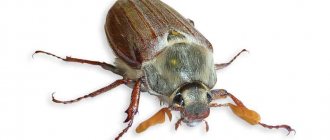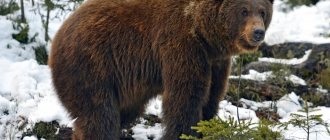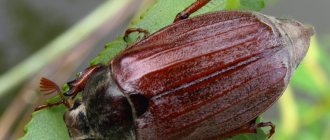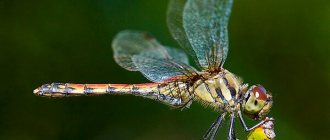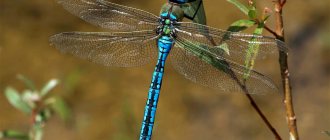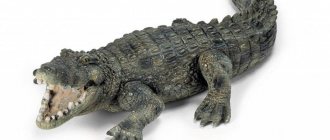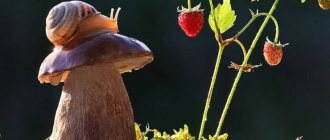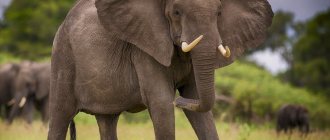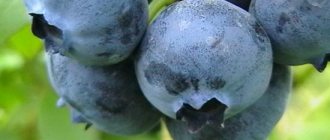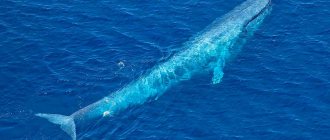May beetles or May beetles (Melolontha hippocastani) belong to the phylum Arthropods, class Insects, genus Melolontha.
This genus consists of 24 species, 9 of which live on the territory of the Russian Federation. The mass appearance of cockchafers occurs in the spring, most often at the end of April and May. Phenologically, the period of appearance of these beetles coincides with the beginning of oak buds and the mass leafing out of birch trees. If you look closely at the ground on these warm spring days, you can see cockchafers crawling out of it after wintering and flying into the air.
On spring evenings, especially near green, flowering trees, you can often hear them buzzing and see them flying.
Landing on trees, they damage young leaves and flowers, so May beetles cause enormous damage to agriculture and forestry. And during the day you may not notice these beetles on a tree or bush; they sit there, clinging to the branches with their legs.
Appearance of the cockchafer
The body of the cockchafer, like most insects, is covered with a chitinous shell, performing the functions of an external skeleton and protection.
Sizes of the cockchafer
The beetles reach a length of 2 to 3.5 cm.
May beetle coloring
Adult individuals are characterized by color dimorphism, that is, individuals may differ in color from each other.
In general, entomologists distinguish two color varieties (aberrations) of chafer beetles: red with a red pronotum and legs (rex) and black with black pronotum and legs (nigripes). These aberrations are considered to be ecological forms of Mayweed.
Beetles with red coloration mainly live in open places with weak shade, while beetles with black coloration live in shaded places, including under the canopy of not very dense forests. Red beetles are found mainly in the northern regions, and black ones in the southern regions. In the center of the species' range, there are approximately equal proportions of beetles of both varieties.
Habitats
May beetles live in Europe and Asia, mainly inhabiting forest-steppe and forest zones, preferring young pine forests.
Within the city limits, these beetles can often be seen in artificial plantings and near flowering fruit trees and shrubs. On trees or shrubs, the beetles feed and mate, after which the females lay eggs, burrowing into the soil.
Nutrition
The cockchafer causes great damage to deciduous and mixed forests, fruit and berry crops. It feeds on leaves, flowers, and damages ovaries.
His favorite delicacies are plum, apple, cherry, hazelnut and walnut; he loves oak and birch. The foliage of shrubs also serves as food for the beetle, and pine needles are also suitable for the eastern species. It eats everything suitable for food in one area, then flies to another.
Nurseries especially suffer from beetle infestations, as they can completely gnaw away young seedlings. The only plants that the insect does not eat are lilac and ash.
The larvae damage the roots of young trees, cereals and vegetables, causing the plants to die. These nasty-looking, translucent worms (popularly called “chrobak” or “furrowworm”) are well known to gardeners. If measures are not taken against them in time, they can destroy all seedlings.
The structure of the cockchafer
The structure of the May beetle is typical of all beetles.
Body parts of the cockchafer
The body and limbs are divided into segments - segments. The beetle's body consists of three sections: head, thorax, and abdomen. In this case, the chest consists of 3 segments, and the abdomen - of 8.
External structure of the cockchafer
The body is covered with small hair-like scales, the head and pronotum are covered with longer hairs that form longitudinal stripes, the underwings may also be covered with hairs.
Head of a cockchafer
On the head there are antennae that have an elongated 3 segment, and in males they end in a strongly curved club, which consists of 7 identical plates.
The limb of a cockchafer
Walking legs (3 pairs) are located on the chest, so each pair of legs corresponds to one segment of the chest. The limb itself is covered with hairs and consists of movably connected segments, which end in claws, with the help of which insects cling to the bark of trees and foliage. Also, the front legs are quite strong and look like scrapers, since the beetle digs a hole with them when laying eggs.
May beetle wings
Wings are attached to the top of the chest: to the second segment are strong chitinous brown elytra that support the beetle’s body in flight, to the third segment are transparent flying wings. The cockchafer is rather clumsy, flies slowly and heavily.
Popular varieties
Today, experts know about 63 species of insects. However, only a few species are common and live near populated areas:
- The eastern or wild chestnut May beetle reaches a length of 30 mm. Individuals have pronounced sexual differences, since females are significantly larger in size than males. A distinctive feature of the insect is the ability to change color from black to dark brown or burgundy. The beetle's legs and antennae are somewhat different from the western species, but the larvae and juveniles are very similar. The wild chestnut beetle feeds on pine needles, leaves of chestnut, birch, and willow. The beetle lives in Asia and Europe and has two varieties that differ in appearance.
- The Western Khrushchev has a convex and strong body, reaching 31 mm in length. Unlike the eastern one, this species is more thermophilic, and its flight begins almost 2 weeks later. The color of the insect is light brown, but the head and abdomen are black. The beetle feeds on the leaves of maple, beech, poplar, walnut, willow, and plum. Individuals give preference to young trees.
- The Caucasian beetle is considered a rare species and lives exclusively in Germany and Austria, namely in the southwestern part. The maximum length is 28−29 mm. The difference between the individual and other varieties is the presence of long “hair”. There are whitish dots on the pronotum of the beetle. Females differ from males because the 4th pair of antennal segments is elongated.
- March Khrushchev has smaller dimensions, not exceeding 23 mm in length. The back and head of the insect are covered with thick scales resembling hairs. Between these hairs grow other, longer and softer ones. The body of an individual is almost always black, with a bronze tint.
There are many more varieties, the differences of which are invisible to the naked eye. On the territory of Russia, Western and Eastern Khrushchi are most often found.
Organs of the cockchafer
A well-developed system of sensory organs helps chafers navigate in space. So on the head of the beetle there are organs of touch, smell and vision.
Organs of the cockchafer's head
The organs of smell are the antennae; with their help, the insect searches for food, sometimes flying distances of more than a kilometer. The organs of touch are the palps of the oral appendages. The organs of vision are the compound eyes, which are located on the sides of the head. Such eyes consist of thousands of simple eyes and make it possible to see everything that happens around.
The nervous system controls such complex processes of perception and, in general, the work of the entire organism. The central nervous system consists of the brain, the ventral nerve cord, which runs along the ventral side of the body, and the peripharyngeal ganglion.
The brain consists of three sections. The peripharyngeal ganglion is well developed. Almost all of these sections secrete neurosecrets that are responsible for the growth and development of the cockchafer.
What does the cockchafer eat?
Beetles feed on solid plant food, so the oral apparatus and digestive system as a whole are adapted to such nutrition. The cockchafer's digestive system begins with its mouth, which is located on the underside of its head.
The oral apparatus is of a gnawing type, so the bitten food is crushed with the help of the upper and lower jaws and falls into the pharynx, then into the long esophagus. The esophagus has an extension - the goiter, from which food enters the chewing stomach.
Here, food is finally ground with the help of hard chitinous plates and enters the digestive stomach (midgut), where, under the influence of digestive juices, it is digested and absorbed.
Food that is not digested goes into the hindgut, which ends at the anus. It is located at the end of the abdomen. Also in the process of choosing food, movable oral appendages - palps - take part, with the help of which May beetles feel and bring food to the mouth. Without these appendages, the animal will not be able to feed and will die.
The cockchafer has a trachea
Beetles breathe atmospheric oxygen, which enters a system of spiracles (18 pieces) located on the chest and abdomen of the insect. Next, from the spiracles, oxygen enters the thinnest respiratory tubes - the trachea, they envelop the organs, and oxygen freely flows to them.
Circulatory system
The circulatory system of the cockchafer is not closed and has a rather primitive structure, since it only carries nutrients.
The heart has the shape of a tube, which is divided into septa with valve openings, located on the dorsal side of the body. The muscles attached to them extend from the chambers to the sides, contracting, they drive the hemolymph into a long blood vessel - the aorta.
From the aorta, hemolymph flows into the spaces between the organs and fills them. Then the hemolymph is collected again in the heart through the chambers. Hemolymph is colorless, contains phagocytes and special blood cells, its main function is to transport nutrients to organs and tissues, as well as transport metabolic products to the organs.
Excretory organs
The functions of the excretory organs in the cockchafer are performed by the Malpighian vessels, which are thin, blindly closed tubes at the free end. They arise from the alimentary canal between the midgut and hindgut.
From the hemolymph, metabolic products enter the hindgut, from where they are excreted through the anus. The fat body also plays an important role in removing metabolic products from the body; round nodules of uric acid are deposited in it. The fat body is a “storage bud” because uric acid is not excreted from it.
Genitals
May beetles are dioecious insects and reproduce only sexually. The eggs in females are located in the ovaries, which are thin-walled tubes.
The testes of males are convoluted tubes that contain seminal fluid. A short time after mating, the male cockchafers die, and the females lay eggs, burying their eggs in the soil to a depth of 30 cm. Having laid the eggs, the female dies; the clutch contains on average up to 70 eggs.
May beetle larva
After a month or a month and a half, the eggs hatch into larvae that live in the soil for 3-4 years. Outwardly, they look like worms, move well in the soil, and are white in color.
Due to the fact that they live underground they have no eyes. The oral apparatus of the gnawing type is well developed, thanks to which the larva of the cockchafer digs the ground and feeds on plant debris and plant roots.
In the first year of life, having a still imperfect oral apparatus, the larva feeds on plant debris. And in the second and third years it can already gnaw through quite powerful roots and rhizomes of plants.
Lifestyle and habitat
The beetle lives in Asia, Europe, North America and several islands in Oceania. Most varieties prefer temperate regions, but some are found in the tropics.
The main habitat of the cockchafer is deciduous forests, thickets, and gardens. Insects need not only plants as a source of food, but also loose soil.
This is due to the fact that three of the four stages of the beetle's development cycle take place underground. In addition, both larvae and beetles that hatch in late summer or autumn overwinter here.
The life of the cockchafer is very organized. Insects are most active at night. They spend most of their time searching for food and eating it.
Khrushchev is very peaceful, does not fight with other arthropods and tries to stay away from people.
Metamorphosis of the cockchafer
During its life cycle, the larva goes through several molts and at the end of the last year of life in the soil, in the summer, it enters the next stage of development - the pupa.
Externally, the pupa already resembles an adult beetle, but it does not move or grow, has a white color and short wings. While in this stage, under the influence of hormones, the cockchafer metamorphoses - the growth of wings, limbs, and the formation of visual organs. By the end of summer, the pupae turn into full-fledged beetles, but emerge from the ground only in the spring.
Stages of development of the cockchafer
Thus, there are 4 stages of development of the cockchafer: egg, larva, pupa and imago (adult insect).
Stages of development
In the first summer, the larvae eat humus and grass roots. In winter, it hides 1.5 meters into the ground, and with the arrival of spring it moves closer to the root system of plants.
The two-year-old larva feeds on the roots of a young tree. In the third year, it reaches a size of five to six centimeters; now it can even gnaw the roots of adult trees. In the fourth year of life, the larva transforms into a pupa, and two months later it becomes a beetle.
In winter, the beetles are in suspended animation; with the arrival of spring warmth, the May beetle begins its flight.
Fighting the cockchafer
It has been noticed that in populations there are years with a predominant summer, that is, when a massive flight of the cockchafer occurs. Black beetles develop on a five-year cycle, and red beetles develop on a four-year cycle, so there are three or four-year breaks when chafer beetles are practically not found. Harm to agriculture and forestry is caused by both adults and larvae.
How to deal with the cockchafer?
For many years, scientists have been and are developing methods to reduce the number of cockchafers. So in the 50-60s, E. Khober and in the 70s, Ya. P. Tsinovsky and his group sterilized male May beetles with ionizing radiation and released them into nature.
This method made it possible to achieve a sharp reduction (75-100%) in the population size, which contributed to plant protection. But the method has not become widespread due to the need to collect a large number of males at the required time for irradiation.
Fighting cockchafer larvae
Modern summer residents recommend manually collecting and killing adult beetles from plants or destroying the larvae while digging up the soil.
